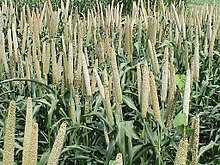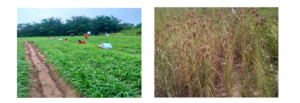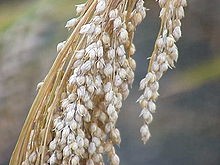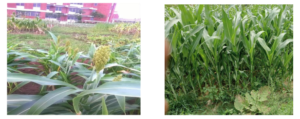Millet renaissance in India: Cultivating sustainability for national food security and livelihood enhancement – A Tripura perspective
Authors: Kanika Kalai1*, Apurba Debbarma2 and Purabi Barman 3
Authors affiliation:
1* Assistant Professor, Department of Veterinary Pathology, C.V.Sc and A.H, R.K. Nagar, West, Tripura-799008
2Assistant Professor, Department of Veterinary Parasitology, C.V.Sc and A.H, R.K. Nagar, West, Tripura-799008
3 Professor, Department of Gynaecology and Obstetrics, C.V.Sc and A.H, R.K. Nagar, West, Tripura-799008
Abstract:
The resurgence of millets in India marks a transformative shift towards sustainable agriculture, nutritional security, and cultural revitalization. Often termed as the “forgotten grains,” millets are experiencing a remarkable revival, driven by their exceptional nutritional profile, climate resilience, and deep-rooted cultural significance. This resurgence is not merely a dietary trend but a holistic paradigm shift, reconnecting us with our agrarian heritage and paving the way for a healthier, more sustainable future.
Millets, comprising varieties like pearl millet, finger millet, foxtail millet, and sorghum, are renowned for their rich nutritional composition, including protein, fiber, essential minerals, and low glycemic index properties. They play a crucial role in addressing malnutrition, promoting overall well-being, and offering versatile options in culinary traditions across India.
Moreover, research institutions such as ICRISAT and ICAR-Indian Institute of Millets Research, along with international collaborations, are advancing millet-centric agroecological solutions and sustainable food systems. The cultivation of millets not only diversifies cropping patterns but also enhances soil health, mitigates erosion, and contributes to ecosystem resilience.
In Tripura, millet cultivation holds immense potential in enhancing food security, supporting livestock rearing, and bolstering agricultural resilience. Government initiatives, including the National Food Security Mission and Mission Organic Value Chain Development for North Eastern Region, along with support from organizations like NABARD, are fostering millet cultivation through financial aid, value chain development, and awareness programs.
In conclusion, the renaissance of millet production in India signifies a journey of rediscovery, resilience, and reconnection with our agricultural roots. By embracing millets, we embark on a path towards a more sustainable and nutritious future, ensuring food security, improving livelihoods, and celebrating the cultural richness embedded in our culinary traditions.
Introduction:
Millets, often referred to as the “forgotten grains,” are experiencing a remarkable resurgence in India, spearheading a nutritional and agricultural revolution across the country. The world celebrated 2003 as international year of millets. These ancient grains, once overshadowed by mainstream cereals, are now reclaiming their rightful place on our plates and in our fields, driven by their exceptional nutritional profile, climate resilience, and cultural significance. Embedded deeply in the cultural fabric of India, millets have been cherished for centuries across diverse cuisines and culinary traditions. From the quintessential “bajra ki roti” of Rajasthan to the wholesome “ragi mudde” of Karnataka, “Maichwi” (foxtail millet) of Tripura and the delectable “jowar bhakri” of Maharashtra, millets have adorned our plates in myriad forms, reflecting the culinary diversity and richness of our land. Their revival not only reconnects us to our culinary roots but also celebrates the sustainable and wholesome traditions of our ancestors.
Millets are a group of small-seeded grasses, primarily grown for food and fodder. The crops are renowned for their exceptional nutritional composition, making them indispensable in addressing malnutrition and promoting overall well-being. Rich in protein, fiber, essential minerals such as iron and calcium, and possessing low glycemic index properties, millets offer a plethora of health benefits. From combating diabetes and cardiovascular diseases to promoting digestive health and weight management, millets emerge as nutritional powerhouses with unparalleled versatility.
Some common types of millets include:
- Pearl Millet (Bajra) (Fig:1): Widely grown in Africa and the Indian subcontinent, pearl millet is rich in protein, fiber, and minerals.

Fig:1 Pearl millet
- Finger Millet (Ragi) (Fig:2): Mainly cultivated in Africa and Asia, finger millet is a rich source of calcium, iron, and amino acids.

Fig:2 Finger millet cultivation in Tripura (NABARD)
- Foxtail Millet(Fig:3) : Popular in East Asia, foxtail millet is high in carbohydrates and provides various nutrients, including magnesium and phosphorus.

Fig: 3 Foxtail millet cultivation in jhum system in Tripura
- Proso Millet (Fig:4): Grown in many parts of the world, proso millet is versatile and used for human consumption as well as bird feed.

Fig:4 Proso millet
5.Sorghum (Jowar) (Fig:5): While sorghum is often classified as a type of millet, it’s worth noting that it is a broader category. Sorghum is a cereal grain that includes varieties used for both human consumption and animal feed.

Fig:5 Sorghum
Some important features and importance of millets:
- Nutritional Value: Millets are rich in nutrients like protein, fiber, vitamins, and minerals. They provide essential nutrition not only to humans but also to livestock when used as fodder. Millets such as sorghum, pearl millet, and finger millet are commonly used as livestock feed due to their high nutritional content.
- Drought Resistance: Millets are known for their ability to grow in semi-arid and drought-prone regions, making them a preferred choice for cultivation in areas like Tripura where water availability may be limited or erratic. Their ability to thrive in such conditions ensures a stable food and fodder supply even during periods of water scarcity. Their deep root systems enhance soil fertility, mitigate erosion, and contribute to ecosystem resilience, fostering a harmonious relationship between agriculture and the environment
- Fodder for Livestock: Millets serve as an excellent source of fodder for livestock, providing essential nutrients for their growth and development. They are particularly valued for their high protein content, which is crucial for maintaining the health and productivity of dairy cattle, poultry, and other livestock.
- Income Generation: Millet cultivation offers income generation opportunities for farmers, including those in Tripura. Besides selling millets in the market for human consumption, farmers can also sell surplus millet fodder to other livestock owners, thereby increasing their income and improving their livelihoods. The resurgence of millets is not just a nutritional triumph but also an economic boon for millions of farmers across India. By diversifying cropping patterns and integrating millets into agroecosystems, farmers enhance their resilience to climate variability, reduce production risks, and secure livelihoods. Furthermore, the growing demand for millets in domestic and international markets creates lucrative income opportunities, especially for smallholder farmers and women farmers.
- Crop Diversification: Millets contribute to crop diversification efforts, which are essential for maintaining soil health and biodiversity. Introducing millets into crop rotations helps break disease cycles, reduce pest pressures, and improve soil fertility, ultimately benefiting both crop and livestock production.
- Climate Resilience: With climate change posing challenges to agriculture, including unpredictable rainfall patterns and increased instances of extreme weather events, the cultivation of millets can contribute to building resilience in farming systems. Their ability to withstand drought and thrive in marginal environments makes them an important crop for climate-smart agriculture initiatives.
- Government Initiatives and Policy Support: Recognizing the pivotal role of millets in achieving food and nutritional security, the Government of India has launched various initiatives and policy interventions to promote millet cultivation, consumption, and value addition. Programs such as the National Food Security Mission, Paramparagat Krishi Vikas Yojana, and the National Mission on Sustainable Agriculture prioritize millets as strategic crops, offering financial incentives, technical support, and market linkages to farmers.
- Global Recognition and Collaboration: India’s millet renaissance has garnered international acclaim, positioning the country as a global leader in millet research, production, and advocacy. Collaborative efforts with international organizations such as the Food and Agriculture Organization (FAO) and research institutions worldwide further amplify India’s role in advancing millet-centric agroecological solutions and sustainable food systems on the global stage.
Use of millets in animal nutrition
Millets are commonly used as feed for various animals due to their nutritional value and adaptability.
The use of millets in animal nutrition includes:
- Livestock Feed: Millets serve as a source of energy, protein, and essential nutrients in the diets of livestock such as cattle, sheep, and goats. They contribute to the overall nutrition of the animals, promoting growth and productivity.
- Poultry Feed: Millets are included in poultry diets as a source of carbohydrates, proteins, and minerals. They provide an alternative to traditional grains and can be used in various forms, including whole millet, millet meal, or millet-based pellets.
- Forage: Certain millet varieties, especially pearl millet, are grown as forage crops for grazing animals. These plants can be used as fodder, providing a source of nutrition for livestock.
- Bird Feed: Millets like proso millet are used in bird feed, particularly for species like game birds, wild birds, and pet birds. Their small size makes them suitable for various bird species.
- Aquaculture: Some millet varieties, such as foxtail millet, are used in fish feed for aquaculture. They contribute to the balanced nutrition of fish and other aquatic species.
Millets are also used as forage pasture. Millet grows rapidly and can be grazed 5–7 weeks after sowing, when it is 20–30 cm high. The highest feed value is from the young green leaf and shoots. The plant can quickly come to head, so it must be managed accordingly because as the plant matures, the value and palatability of feed reduces. Animals gain weight faster on millet pasture and it has better hay or silage potential, although it produces less dry matter
The use of millets in animal feed helps diversify feed sources, enhances nutritional content, and can be particularly beneficial in regions where millets are staple crops for both human and animal consumption.
Diseases of animals related with millet feeding
Millet consumption by animals is generally not associated with specific diseases. In fact, millets are often considered beneficial components of animal diets due to their nutritional value. However, it’s important to consider a few factors:
- Mycotoxin Contamination: Millets, like other grains, can be susceptible to mycotoxin contamination under certain conditions. Mycotoxins are toxic substances produced by fungi, and their presence in animal feed can lead to health issues. Proper storage and handling of millet can help mitigate the risk of mycotoxin contamination.
- Balanced Nutrition: While millets offer nutritional benefits, it’s crucial to ensure a balanced diet for animals. Depending solely on millets may not provide all the necessary nutrients. Supplementation and a well-formulated diet are essential for the overall health and productivity of animals.
- Storage and Handling: Improper storage conditions can lead to the development of molds and deterioration of millet quality. Animals consuming mold-contaminated millet may be at risk of mycotoxicosis or other health issues.
- Species-Specific Considerations: Different animals have varying nutritional requirements. It’s important to consider the specific needs of the animal species in question when formulating diets that include millets.
Millets can be a valuable component of animal diets, but attention should be given to factors like mycotoxin contamination, balanced nutrition, and proper storage to ensure the health and well-being of the animals. Regular monitoring and good agricultural and storage practices can help mitigate potential risks. Research on millets is carried out by the International Crops Research Institute for the Semi-Arid Tropics (ICRISAT) and ICAR-Indian Institute of Millets Research in Telangana, India, and by the United States Department of Agriculture’s Agricultural Research Service at Tifton, Georgia, United States
Millet production in Tripura
In Tripura Millets are cultivated on 1,300 hectares of land and the state has adopted programmes to increase this by 700 hectares in 2023-24. Under ‘National Food Security Mission – clustered demonstration of millet ‘Nutri Cereals’ is being implemented for last few years with financial support of Rs. 6,000/- per ha to the farmers for cultivation of millets. And under Mission Organic Value Chain Development for North Eastern Region (MOVCDNER), value Chain on Millet is also being developed. In addition to these NABARD is also implementing and organizing various schemes, seminars and camps for millet cultivation in the state.
In conclusion, the resurgence of millets in India transcends mere dietary trends; it embodies a holistic paradigm shift towards sustainable agriculture, nutritional security, and cultural revival. As we embrace millets with renewed fervor, we embark on a journey of rediscovery, resilience, and reconnection with our agrarian heritage, paving the way for a healthier, more sustainable future for generations to come.
In Tripura, millet cultivation can play a vital role in enhancing food security, supporting livestock rearing, and improving the resilience of agricultural systems. Government support through policies promoting millet cultivation, research and development initiatives aimed at enhancing millet productivity and quality, and extension services to educate farmers about the benefits of millet cultivation can further boost its importance in the region. Additionally, value addition activities such as processing millets into nutritious animal feed supplements can create additional income streams for farmers and contribute to the overall development of the livestock sector in Tripura.
References:
International Year of Millets 2023. Food and Agriculture Organization of the United Nations. International Year of Millets. Retrieved 2023-02-15.
Nutritional Health Benefits of Millets" (PDF). Indian Institute of Millets Research. Retrieved 2023-02-15.
https://www.nabard.org/international-year-of-millets-2023/pdf/millets-intiatives-in-tripura.pdf
Mishra P (2023-01-04). How the International Year of Millets will boost Indian millets; Business Line. Retrieved 2023-02-15.
Kumar K B (2023). Business Matters. Why did UN declare 2023 as International Year of Millets? The Hindu. ISSN 0971-751X. Retrieved 2023-02-15.
Post Agriculture (2023-01-26). Indian delegation visits Nigeria for taking South-South Cooperation on millets to next stage". Agriculture Post. Retrieved 2023-02-18.
Tripathi S (2023-02-03). Budget 2023-24 Encourages Millets and Good Health: Outlook Planet. Retrieved 2023-02-18.

